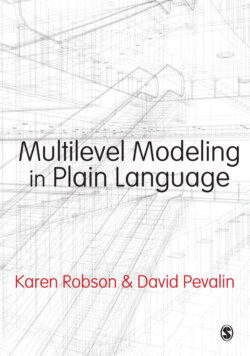Читать книгу Multilevel Modeling in Plain Language - Karen Robson - Страница 18
На сайте Литреса книга снята с продажи.
How this book is organized
ОглавлениеThis book is organized into four chapters. This introductory chapter is followed by a chapter on random intercept models. This starts with a very quick review of OLS single-level regression to get us all on the same page and then gradually introduces random intercept models, how these differ from single-level OLS regression, and how to explore the nesting structures in your data. There are a few points where we touch on ongoing debates in the multilevel modeling community. Not everything is clear-cut, but we try to steer you through these without getting stuck in the technicalities (and probably a never-ending debate!). We continue with developing random intercept models, building up slowly with plenty of illustrations and example commands and output which is explained. We try not to throw too many equations at you, but when we do, we explain them in words. We look at adding independent variables at different levels, interaction effects, model fit statistics, and model diagnostics. Throughout, we try to follow the same example, but at times we have to deviate from that to demonstrate some points.
Chapter 3 is about random coefficient models, sometimes called random slope models. These are more complicated models than random intercepts, and we recommend that you read through Chapter 2 before starting out on this chapter. We pretty much follow the same topics as with random intercept models.
Of course there will be more detail in the chapters, but to conclude this introductory chapter we will simply remark that random intercept models look like this, with parallel regression lines for each group:
And random coefficient models look like this, with group regression lines which are not parallel to each other:
In Chapter 4 we turn to how to present results from these models and how to use Stata to produce publication-quality tables.
